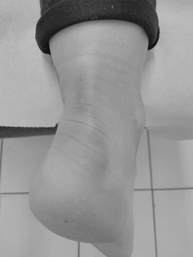 I'm not talking about the old word for homosexuality. I'm talking about your ankles. So what does inversion mean in respect of you ankle? Technically inversion is a movement in one plane only, meaning sidebent inwards . In reality, most of the time we are taking about about supination, which is a movement in 3 planes of motion, if you know your anatomical terms then it is made up of inversion of the hindfoot, adduction of the forefoot, and plantarflexion of the talocrural (ankle) regions. If not, don't worry just think that inversion is a pure movement at one joint in the heel and supination is the more complex movement that occurs more often in reality. Your foot tips into inversion/supination much more easily than it does into eversion/pronation...try it, it turns inwards easily and a lot and outwards not so much. As a result most ankle sprains and twists are into inversion. I have been surprised how many of my patients presenting with all sorts of issues have one or two ankles which are held in inversion, that is to say that either the hindpart or the whole of the foot can't present straight to the floor. How can this occur? Well, you can have a pure supination, it can occur in the talo-crural joint (talus top bone of foot and and crus, referring to the paired leg bones) where the tenon like talus gets wedged supinated betweeen the two sides of the mortice formed of the ends of the tibia and fibula, or the sub talar joint can become restricted and hold the foot in the inverted position. In addition the tibialis anterior and posterior muscles in the shin and calf can become tight or shortened and contribute to holding the foot in this position and I have often seen a fixed twist in the midfoot as it everts to reverse the deformity and present the forefoot flat on the floor. Without correction this fixed twist will also be acting to maintain the inversion of the back of the foot. Finally, right up by the knee is you superior tibiofibular joint, if that gets stuck in a position with the fibular relatively inferior to its proper position then the whole mortise of the talocrural joint will force inversion How do I spot this? It's very simple. When I look at you from behind, your achilles tendon should run in a fairly straight line and the bulge of your heel bone (calcaneus) should be approximately symmetrical either side, if not, something is wrong. I can confirm this by feel and by feeling whether it moves evenly compared to the other side and the range of normals I have felt over the years. If the heel has been like this for some time the insertion of the achillles tendon will even move so that it no longer attaches at the pointy top of the calcaneus but instead attaches to the side, I can feel this too. Why is this important? Well, the first effect will be on your foot. If your hindfoot is pronated you will need to twist through your midfoot to place the front of the foot flat when you walk and that may cause problems in the midfoot and tightness in muscles which are being over-stretched in the shin, maybe even shinsplints. You may not have the midfoot mobility to do that so may be walking on the outside of your foot...or more likely as you present your foot flat your knee has to drop inwards (valgus) to compensate. Therein lies a whole can of worms. When you have a knee valgus, first of all you are going to be stretching and stressing the ligament on the medial part of the knee (the inner part, nearest your other knee). The medial collateral ligament, as it is called, is attached to the medial meniscus, this is a cup shaped piece of cartilage which sits between your femur (thighbone) and your tibia (shinbone). If you are stretching the medial collateral ligament you are also deforming the medial meniscus and may well make it more prone to tearing. what is more the proportion of the weight taken by the lateral meniscus has increased, making that more prone to damage also Once a structure is out of line, as with a knee in valgus then it is not supported against gravity by the structures beneath it, to stop it collapsing force is required, this is supplied by muscles. Locally, vastus medialis oblique (VMO) is the muscle that tries to stop it dropping. Over time over use of VMO can lead to it becoming over tight or fatigued and ineffectual. As one of the quadriceps muscles it contributes to the joint quadriceps tendon which encapsulates the kneecap, imbalances in the forces inputting into this tendon can cause the knee cap to become bound down onto the structures below or to move in an irregular fashion (maltracking), both of which can cause pain, damage to the cartilage on the back of the kneecap, and eventually arthritis. Your body also stops the knee dropping further inward by pulling the hip outward, using gluteus medius and minimus. Gluteus maximus and tensor fascia lata are also involved as, via the iliotibial band, they try to hold the knee joint close and stable. All of these muscles can become over tight or fatigued as a result of this process and iliotibial band tightness can occur, possibly leading to trochanteric bursitis. Of course, most of us don't have symptoms, but what damage is this storing up for the future. Is this a significant contributing factor for knee, or even hip osteoarthritis? I don't have any evidence to say it is, but mechanically it seems reasonable to assume that there will be long-term effects. I also wonder how many people get a running shoe based on how they weight bear but are actually not weightbearing as they should...and most of the time this is so easy to fix. Anyway, next time you see someone from behind with flipflops on, or bare feet, take a look, you'll be surprised how many inverted ankles you'll find
1 Comment
Annie
27/6/2018 14:19:59
I wear my shoes down on the outside first, and I think this explains it!
Reply
Your comment will be posted after it is approved.
Leave a Reply. |
Archives
February 2024
AuthorDamian is the principal osteopath at Vauxhall Village Osteopathy and Oval Osteopathy Categories
All
|


 RSS Feed
RSS Feed


